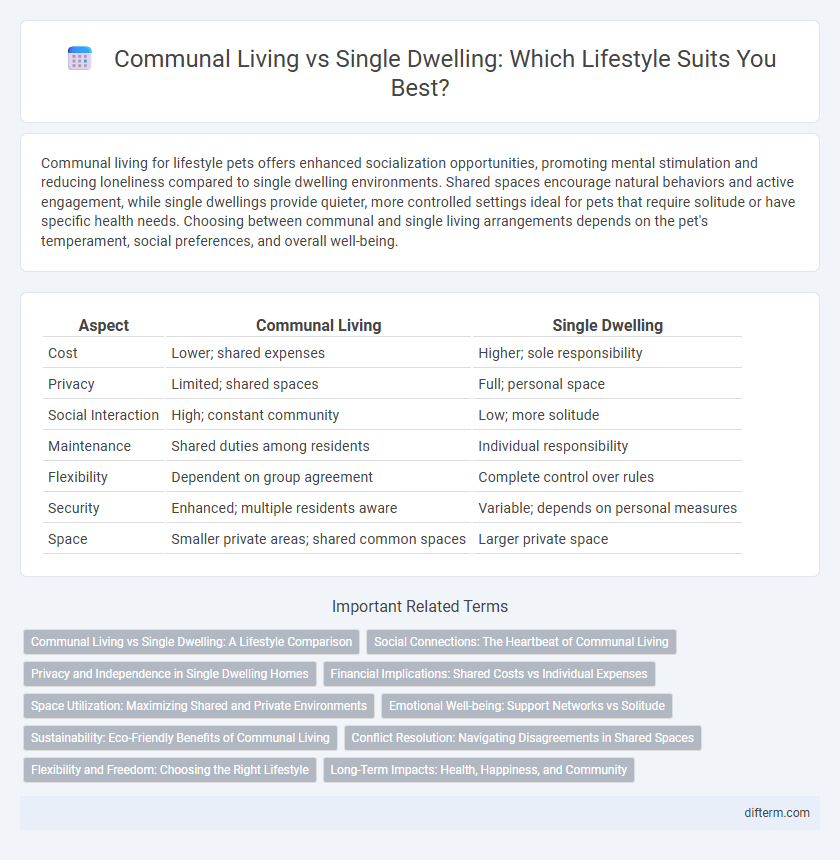Communal living for lifestyle pets offers enhanced socialization opportunities, promoting mental stimulation and reducing loneliness compared to single dwelling environments. Shared spaces encourage natural behaviors and active engagement, while single dwellings provide quieter, more controlled settings ideal for pets that require solitude or have specific health needs. Choosing between communal and single living arrangements depends on the pet's temperament, social preferences, and overall well-being.
Table of Comparison
| Aspect | Communal Living | Single Dwelling |
|---|---|---|
| Cost | Lower; shared expenses | Higher; sole responsibility |
| Privacy | Limited; shared spaces | Full; personal space |
| Social Interaction | High; constant community | Low; more solitude |
| Maintenance | Shared duties among residents | Individual responsibility |
| Flexibility | Dependent on group agreement | Complete control over rules |
| Security | Enhanced; multiple residents aware | Variable; depends on personal measures |
| Space | Smaller private areas; shared common spaces | Larger private space |
Communal Living vs Single Dwelling: A Lifestyle Comparison
Communal living fosters social connections and shared responsibilities, enhancing emotional well-being and reducing living costs compared to single dwelling arrangements. Single dwellings offer greater privacy and autonomy, allowing residents to tailor their environment without compromise. Choosing between these lifestyles depends on personal priorities such as social interaction, financial considerations, and desired independence.
Social Connections: The Heartbeat of Communal Living
Communal living fosters stronger social connections by creating daily opportunities for meaningful interactions and shared experiences, enhancing emotional well-being and reducing feelings of isolation. Single dwelling, while offering privacy, often limits spontaneous social engagement, potentially impacting mental health over time. Building a supportive community through shared spaces nurtures a sense of belonging that single living environments struggle to replicate.
Privacy and Independence in Single Dwelling Homes
Single dwelling homes offer enhanced privacy by providing residents with exclusive control over their living spaces, minimizing noise and interruptions from neighbors. This independence supports personalized routines and lifestyle choices without compromise, fostering a sense of autonomy and self-reliance. The separation from communal areas reduces potential conflicts, promoting a peaceful and secure environment tailored to individual preferences.
Financial Implications: Shared Costs vs Individual Expenses
Communal living significantly reduces individual financial burdens by distributing expenses such as rent, utilities, and maintenance across multiple residents, resulting in lower monthly costs compared to single dwellings. Shared resources like kitchen appliances, internet, and furniture further decrease personal expenditures, enhancing overall affordability. Conversely, single dwelling occupants face higher individual financial responsibility due to sole payment for housing, utilities, and upkeep, which can strain personal budgets despite increased privacy.
Space Utilization: Maximizing Shared and Private Environments
Communal living optimizes space utilization by combining shared amenities such as kitchens, lounges, and recreational areas, reducing individual living space requirements while promoting social interaction. Single dwellings allocate more square footage to private zones, offering solitude but often underutilizing space compared to communal models. Efficient design in communal living balances privacy with community, enhancing overall space efficiency and residents' quality of life.
Emotional Well-being: Support Networks vs Solitude
Communal living fosters emotional well-being by providing strong support networks, reducing feelings of loneliness, and enhancing social interaction. In contrast, single dwelling offers solitude that can promote introspection and personal growth but may increase the risk of isolation and emotional distress. Balancing the need for connection with the benefits of privacy is crucial for maintaining mental health in diverse lifestyle choices.
Sustainability: Eco-Friendly Benefits of Communal Living
Communal living significantly reduces carbon footprints by sharing resources such as energy, water, and appliances, leading to lower overall consumption compared to single dwellings. Shared spaces and collective waste management promote recycling and composting efforts, enhancing sustainability. The eco-friendly benefits also include reduced land use and foster a stronger connection to local food production and community-supported agriculture.
Conflict Resolution: Navigating Disagreements in Shared Spaces
In communal living, conflict resolution requires clear communication and empathy to address disagreements over shared resources and personal boundaries effectively. Establishing house rules and regular group meetings fosters a cooperative atmosphere, minimizing tension and promoting mutual respect. In contrast, single dwelling offers solitude that reduces interpersonal conflict but may lack the social support systems inherent in shared living environments.
Flexibility and Freedom: Choosing the Right Lifestyle
Communal living offers flexibility through shared responsibilities and resources, allowing individuals to adapt their schedules and lifestyles more easily. Single dwelling provides greater personal freedom, enabling complete control over one's environment and daily routines. Evaluating priorities such as social interaction versus autonomy helps determine the most suitable living arrangement for a balanced lifestyle.
Long-Term Impacts: Health, Happiness, and Community
Communal living often fosters stronger social connections and a sense of belonging, which can improve mental health and overall happiness compared to single dwelling. Long-term studies show individuals in communal environments report lower stress levels and increased emotional support, reducing risks of loneliness and depression. Single dwelling provides privacy and autonomy but may contribute to social isolation, impacting community engagement and long-term well-being.
communal living vs single dwelling Infographic

 difterm.com
difterm.com